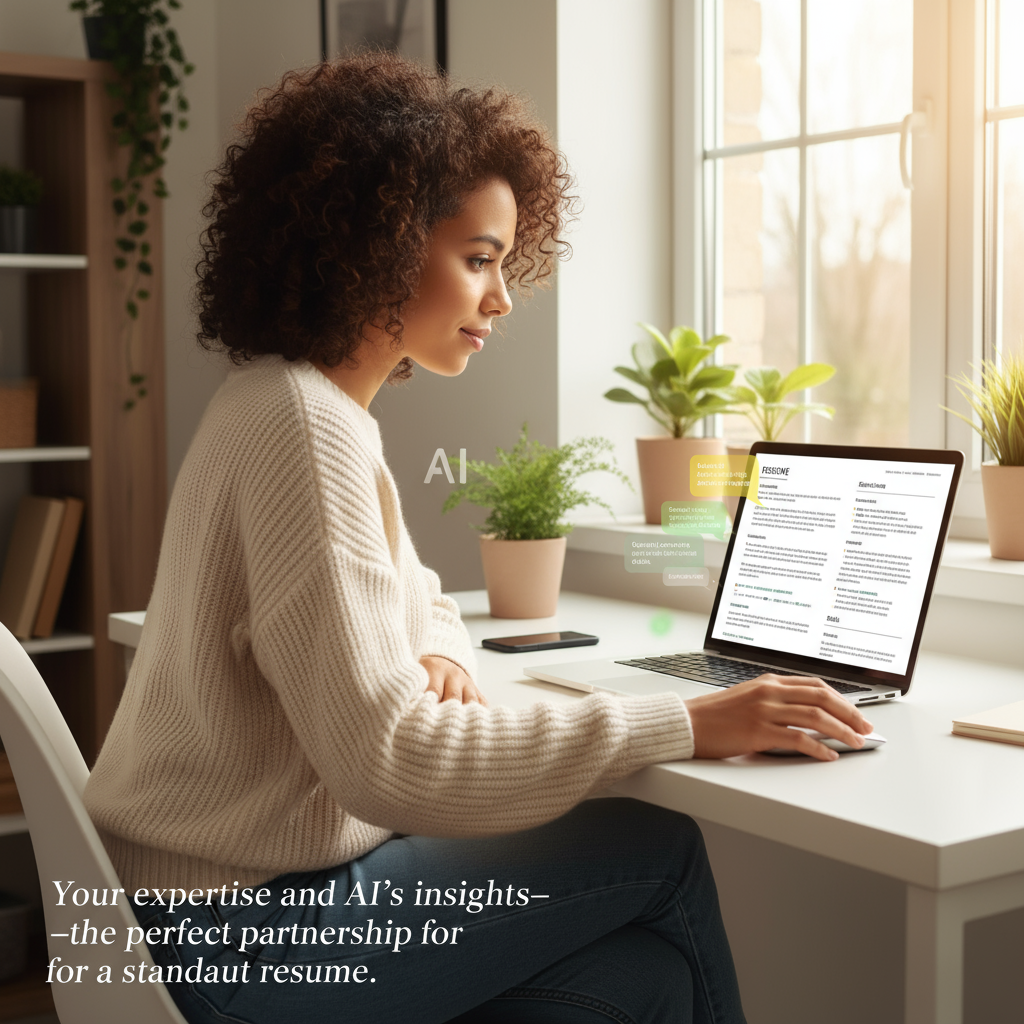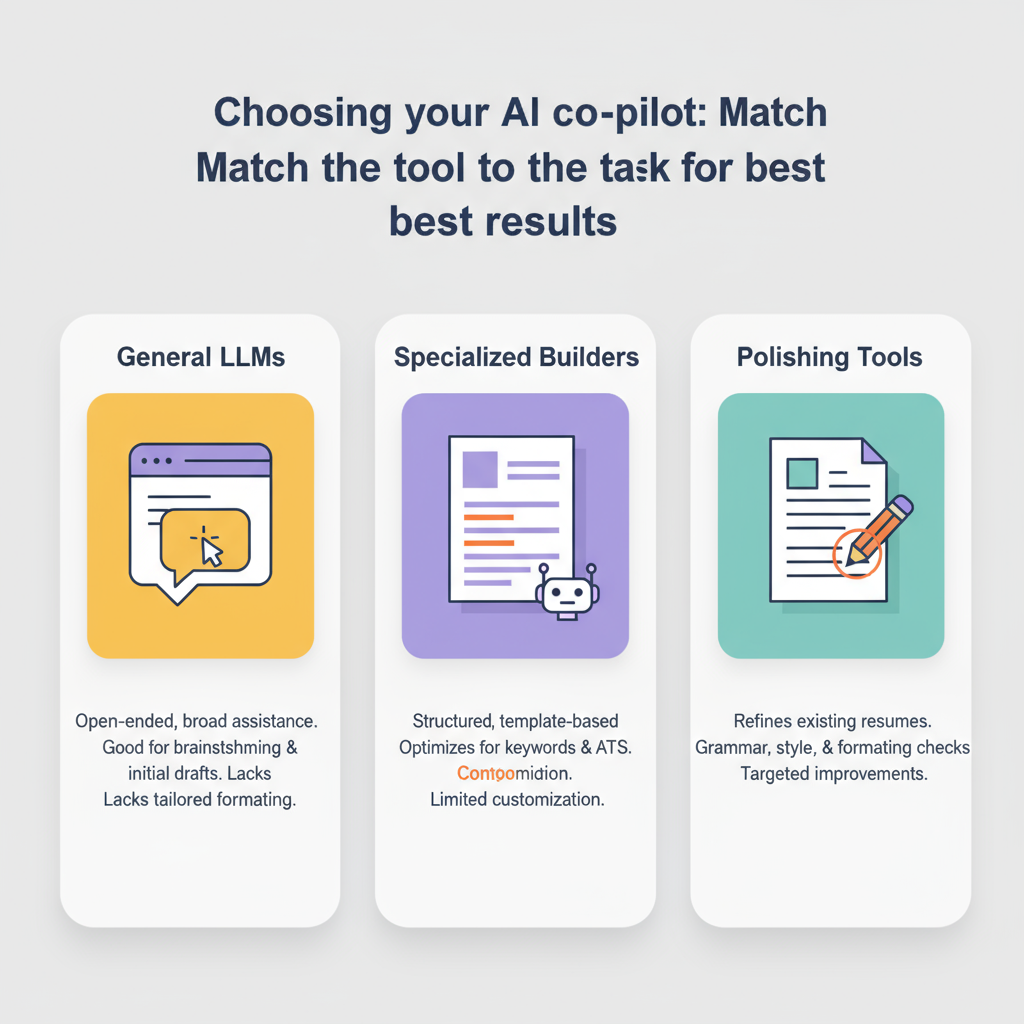Staring at a blinking cursor on a blank resume document is a special kind of dread. You know you've done great work, but translating years of experience into the "right" format feels impossible, especially when you have to tailor it for every single application. What if you could turn that hours-long chore into a focused, 15-minute strategic session? With the right AI tools, you can stop guessing what recruiters want to see and start building a resume that gets you noticed.
Key Takeaways: Your AI Advantage
- Beat the Blank Page: Generate a strong first draft in minutes by feeding an AI your career history, notes, or even your LinkedIn profile.
- Optimize for Robots (and Humans): Instantly identify and weave in the critical keywords and skills that Applicant Tracking Systems (ATS) are searching for.
- Tailor with Precision: Stop manually rewriting bullet points. AI can help you create dozens of targeted variations of your resume for different roles, fast.
- Quantify Your Impact: Turn vague duties into impressive, metric-driven achievements that catch a hiring manager's eye.
- Focus on What Matters: Let AI handle the tedious formatting and phrasing, freeing you up to focus on high-level strategy and storytelling.

Why a Human + AI Combo Always Wins
Let's be clear: AI isn't here to write your resume *for* you. It's here to be your co-pilot. Think of it as an incredibly fast, data-savvy research assistant. It can analyze thousands of data points from job descriptions and successful resumes in seconds—a task that would take you weeks. Your job is to be the strategist, the editor, and the storyteller. You provide the raw materials and the final polish; the AI does the heavy lifting in between. This partnership is what gets results.
Before AI: Spending an hour trying to rephrase a bullet point, hoping it sounds impressive.
After AI: Generating five powerful, data-backed versions of that bullet point in 30 seconds and choosing the one that best tells your story.
The A-C-E Framework for a Flawless AI-Powered Resume
Don't just ask an AI to "write a resume." You'll get a generic, forgettable document. Instead, follow a structured process to get a truly standout result. We call it the A-C-E framework.
1. Assemble: Gather Your Raw Materials
AI works best with good input. Before you write a single prompt, pull together all your career information. This isn't about perfect phrasing yet; it's about data collection. Grab your old resumes, your LinkedIn profile URL, performance reviews, project notes, and even rough lists of your responsibilities. The more context you give the AI, the better its output will be. Feed this raw data into your chosen tool as the foundation.
2. Create: Generate and Analyze
Now, it's time to create the core content. This is a two-part step. First, use a general prompt to build the initial sections. For example: "Using the provided text, create a professional summary and a work experience section for a Senior Project Manager." Second, paste in the job description you're targeting and ask the AI to analyze it. Use a prompt like: "Analyze the job description below and identify the top 10 keywords and skills. Then, suggest ways to integrate them into my work experience." This ensures your resume is perfectly aligned with the role.
3. Edit: Refine and Humanize
This is the most critical step. The AI's draft is just that—a draft. Your job is to transform it from technically correct to compelling. Read every line. Does it sound like you? Is it 100% accurate? Could the metrics be stronger? This is where you inject your personality and unique accomplishments.
AI-Generated Draft: "Responsible for managing project budgets and timelines to ensure successful delivery."
Human-Edited Version: "Managed a $500K project budget, delivering the final product 3 weeks ahead of schedule by optimizing team workflows and resource allocation."
Tired of Guessing Games?
Stop wrestling with formatting and keywords. Livesume’s integrated AI helps you build an ATS-friendly, professional resume in minutes. Let's build your future, together.
Build Your Resume Now
Choosing Your AI Co-Pilot: A Tool Comparison
Not all AI tools are created equal. The right one depends on your needs.
- Large Language Models (ChatGPT, Claude): These are the all-rounders. They're fantastic for brainstorming, overcoming writer's block, and rephrasing content. They are your go-to for the initial "Assemble" and "Create" stages.
- Specialized Resume Builders (Livesume): These tools are the specialists. We integrate AI directly into professionally designed, ATS-vetted templates. This saves you from worrying about formatting and ensures the output is structured correctly from the start. A live resume from a platform like ours often includes features that a simple text document can't match.
- Editing & Polishing Tools (Grammarly): These are your final checkpoint. Use them after you've completed your human edit to catch any lingering grammatical errors or awkward phrasing, ensuring a flawless final document.

Frequently Asked Questions About Using AI for Resumes
Can recruiters tell if a resume was written by AI?
They can if you just copy and paste the initial output. Generic, buzzword-heavy language is a dead giveaway. But if you use the A-C-E framework to guide the AI and heavily edit the final draft, it will be indistinguishable from a human-written resume—just much stronger.
Will an AI-written resume automatically beat the ATS?
It has a much better chance. AI is excellent at identifying and including the exact keywords an Applicant Tracking System is looking for. However, formatting is also key. Using a professional tool like the Livesume builder ensures the structure is also ATS-friendly.
Is it cheating to use AI on my resume?
Not at all. Think of it like using a calculator for a math problem or a spell-checker for an essay. It's a tool to make your work more efficient and effective. You are still providing all the source material—your experience and achievements.
How much of the AI output should I change?
A good rule of thumb is to edit at least 20-30% of the text. This forces you to refine the tone, add specific metrics, and ensure every single word serves a purpose. Never accept the first draft as final.
What's the biggest mistake people make with AI resume writers?
The biggest mistake is trusting it blindly. AI can "hallucinate" or invent details that aren't true. You must fact-check every single claim, date, and metric it produces to ensure your resume is 100% accurate.
Turn Your AI Draft Into a Hiring Signal
You've assembled, created, and edited. Your resume is strong, targeted, and polished. What now? Don't just hit "send." Take these final steps to make sure your application stands out.
- Stress-Test It: Use a tool or even another AI chat to "score" your resume against the job description. Ask it: "On a scale of 1-10, how well does this resume align with the job description? What's missing?"
- Do a Final Human Read-Through: Read your resume out loud. This helps you catch awkward phrasing and typos that your eyes might skim over. Better yet, have a trusted friend or mentor read it.
- Connect Your Story: Your resume is one piece of a larger puzzle. Make sure it aligns with your LinkedIn profile and your digital portfolio. A consistent professional brand is a powerful signal to recruiters.
By using AI as a partner, not a replacement, you transform one of the most painful parts of the job search into a source of confidence. You're no longer just applying for jobs—you're strategically targeting them.